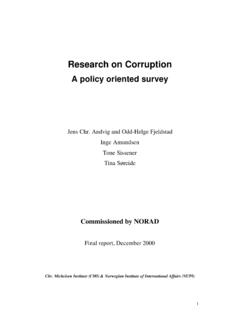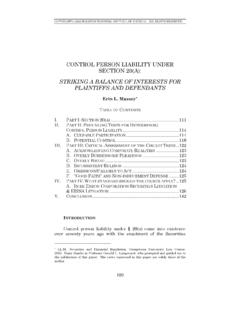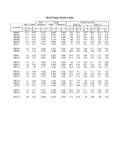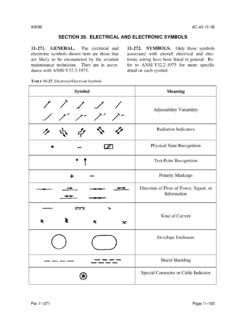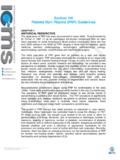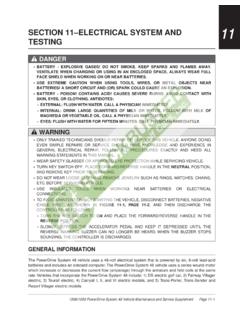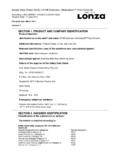Transcription of Consequences and Causes of Corruption – What do …
1 Herausgeber: Die Gruppe der volkswirtschaftlichen Professoren der Wirtschaftswissenschaftlichen Fakult t der Universit t Passau 94030 Passau Consequences and Causes of Corruption What do We Know from a Cross- section of Countries? Johann Graf Lambsdorff Diskussionsbeitrag Nr. V-34-05 Volkswirtschaftliche Reihe ISSN 1435-3520 Adresse des Autors: Professor Dr. Johann Graf Lambsdorff Lehrstuhl f r Volkswirtschaftstheorie Wirtschaftswissenschaftliche Fakult t Universit t Passau 94030 Passau Telefon: (0851) 509-2550 Telefax: (0851) 509-2552 E-Mail: F r den Inhalt der Passauer Diskussionspapiere ist der jeweilige Autor verantwortlich. Es wird gebeten, sich mit Anregungen und Kritik direkt an den Autor zu wenden.
2 Consequences and Causes of Corruption What do We Know from a Cross- section of Countries? Johann Graf Lambsdorff1 University of Passau Abstract Data on the perceived levels of Corruption from a cross- section of countries has been introduced fruitfully into recent empirical research. This chapter reviews studies on the Consequences and Causes of Corruption . It includes research on the impact of Corruption on investment, GDP, institutional quality, government expenditure, poverty, international flows of capital, goods and aid. Causes of Corruption focus on absence of competition, policy distortions, political systems, public salaries as well as an examination of colonialism, gender and other cultural dimensions.
3 JEL-Classification: H3, K42, O57 I. Using Survey Data on Corruption There is currently a wave of empirical investigations on the Causes and Consequences of Corruption . These investigations by and large relate to cross country analyses, based on comparative assessments of the extent of Corruption in various countries. Such assessments are sometimes compiled by agencies to determine country risks and the data gathered are sold to investors. Other sources are surveys of the general public or elite businesspeople. The data on Corruption are thus based on subjective perceptions and expertise, but considered to be good indicators of real levels of Corruption . They allow to bring empirical research on Corruption beyond the anecdotal descriptions that previously dominated.
4 Instead of using perceptions data, Goel and Nelson [1998] and Fisman and Gatti [2002] employ objective data: the number of public officials convicted for abuse of public office in various states of the USA. They assume that high conviction rates are an indicator of actual high levels of Corruption . Goel and Nelson [1998] relate this variable to the real per capita total expenditures of the local government, arguing that state intervention and public spending give rise to rent-seeking activities and hence Corruption . The authors report a significant, positive association between these variables. However, the correlation might be explained differently. As governments increase their spending, the judiciary branch may also be allocated more funding, resulting in higher conviction rates.
5 In this case, conviction rates are not an adequate indicator for the actual incidence of Corruption . Rather, they reflect the quality of the judiciary. The appropriateness of such data as a proxy for Corruption has thus been widely disputed. Due to this, most researchers have used subjective indicators. 1 Johann Graf Lamsbdorff holds a chair position in economic theory at the University of Passau. He can be reached at He is grateful to M. Nell, P. Manow and Teksoz for helpful comments. The Corruption index applied in the subsequent studies was very often that by Transparency International (TI). This is a composite index based on a variety of different assessments made with the help of elite business surveys or expert panels.
6 Some studies used data from these individual assessments, the Institute for Management Development (IMD) or the World Economic Forum (WEF). For a description of these sources see Lambsdorff [2004]. Older sources that are sometimes used in research are the World Bank s Business Environment Survey from 2000, the data by the World Bank and University of Basel (WB/UB) or from Business International (BI; described in Mauro [1995]). Other studies have used the Political Risk Service s International Country Risk Guide (PRS/ICRG). These results must be taken with a grain of skepticism, as this variable does not depict Corruption itself but the political instability that increases with Corruption but also with the public s intolerance towards Corruption .
7 In this regard, instability is assumed to increase with the time a government has been in power continuously a theoretical assumption that not all observers are willing to follow. Another composite index sometimes used is that by Kaufmann, Kraay and Zoido-Lobaton [1999a]. It has the disadvantage of also including the PRS data alongside with other sources of less validity. However, it arrives at results very close to the TI-Index. This review includes all studies that were conducted with a sound level of academic rigor. With less sophistication, the media has been engaged in suggesting various correlations between perceived levels of Corruption and human development, competitiveness, judicial quality, credit ratings or the spread of newspapers.
8 For an overview see Galtung [1997]. Since many other explanatory variables are absent, however, such correlations risk reporting spurious relationships. Whether Corruption Causes other variables or is itself the consequence of certain characteristics is sometimes difficult to assess. Some types of poor government quality and Corruption are sometimes two sides of the same coin. In this case, it can be helpful to observe the correlations that are reported, but one should refrain from drawing iron-clad conclusions with respect to causalities. II. The Consequences of Corruption 1. Total Investment The first investigation on the impact of Corruption on investment in a cross- section of countries was undertaken by Mauro [1995].
9 He makes use of an older Corruption index provided by Business International (BI), a private firm that sold this and related indicators of country risks to banks, multinational companies, and other investors. The author finds that in a sample of 67 countries, Corruption impacts negatively on the ratio of investment to GDP. He claims that if Bangladesh were to improve its level of integrity to that of Uruguay, its investment rate would increase by almost five per cent of GDP. Mauro s finding is supported by similar investigations that use other indices of Corruption and differing samples of countries. Knack and Keefer [1995] incorporate Corruption among other explanatory variables into one single index of "institutional quality" and reveal a negative impact on the ratio of investment of GDP, however, using the data from PRS.
10 Referring to a Corruption index by WB/UB for a sample of 41 countries, Brunetti, Kisunko and Weder [1998: 369] also reinforce the Mauro results. They find that Corruption significantly reduces the ratio of investment to GDP. Mauro [1997] provides further backing for his results by presenting a larger sample of 94 countries and by also making use of the Corruption data by PRS. The data by PRS was also used by Brunetti and Weder [1998] to show that Corruption has a significant negative impact on the ratio of investment to GDP in a sample of 60 countries. A negative impact of Corruption on the ratio of investment to GDP in African countries is reported by Gymiah-Brempong [2002].
